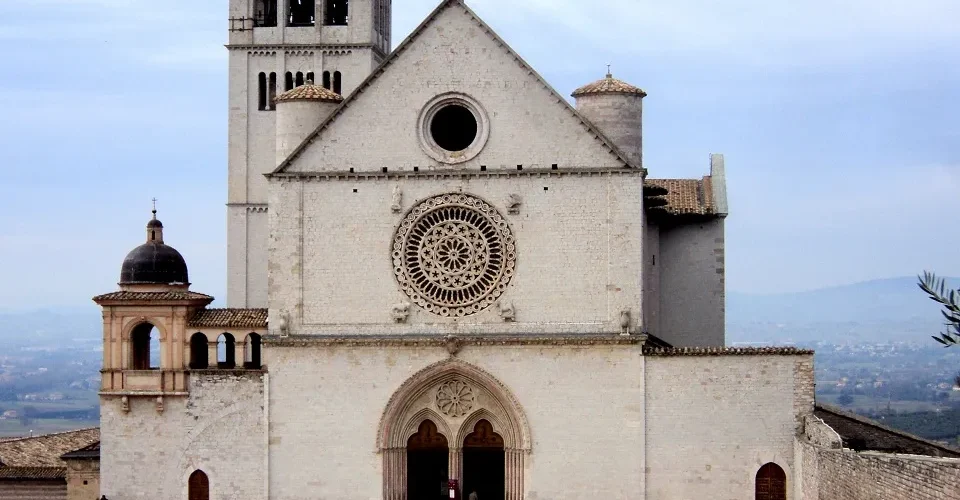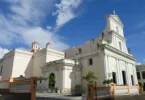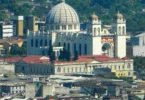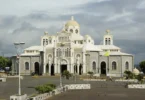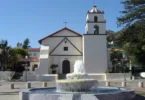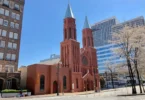Introduction
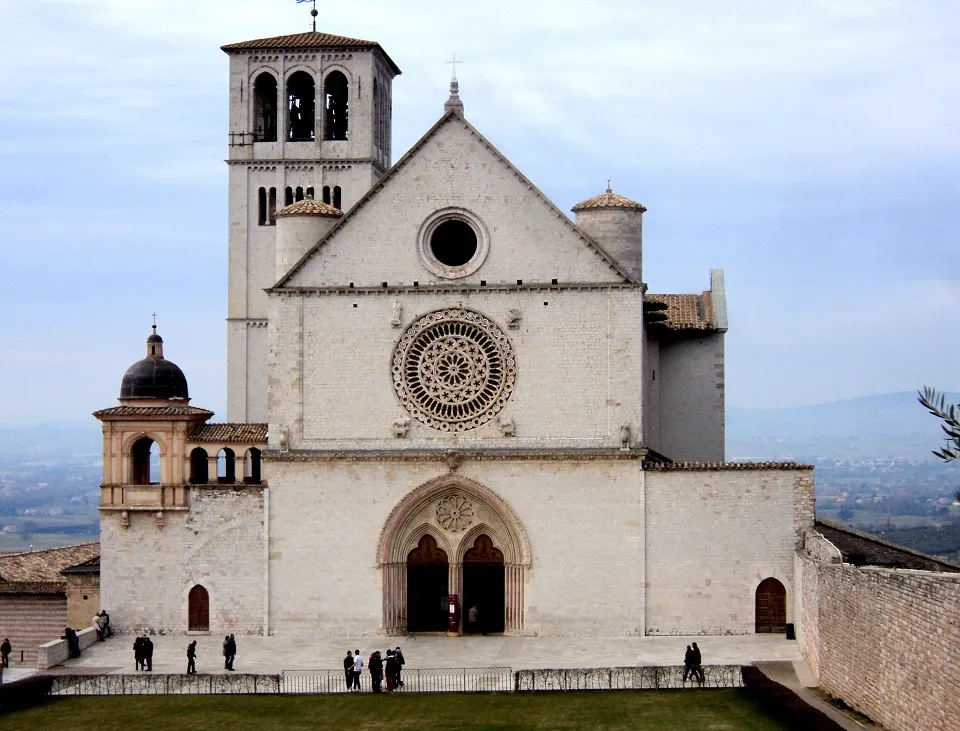
The basilica of holy person francis of assisi (italian: basilica di san francesco d’assisi; latin: basilica sancti francisci assisiensis) is the mother church of the roman catholic request of ministers minor conventual in assisi, a town in the umbria locale in focal italy, where holy person francis was conceived and kicked the bucket. It is an ecclesiastical minor basilica and one of the main spots of christian journey in italy. With its going with friary, sacro convento, the basilica is an unmistakable milestone to those coming assisi. It has been an unesco world legacy site beginning around 2000.
The basilica, which was started in 1228, is incorporated into the side of a slope and contains two chapels (known as the upper church and the lower church) and a sepulcher, where the remaining parts of the holy person are buried. The inside of the upper church is a significant early illustration of the gothic style in italy. The upper and lower temples are enhanced with frescoes by various late middle age painters from the roman and tuscan schools, and incorporate works by cimabue, giotto, simone martini, pietro lorenzetti, and conceivably pietro cavallini. The reach and nature of the works give the basilica a remarkable significance in exhibiting the extraordinary improvement of italian craft of this period, particularly whenever contrasted and the remainder of christian europe.
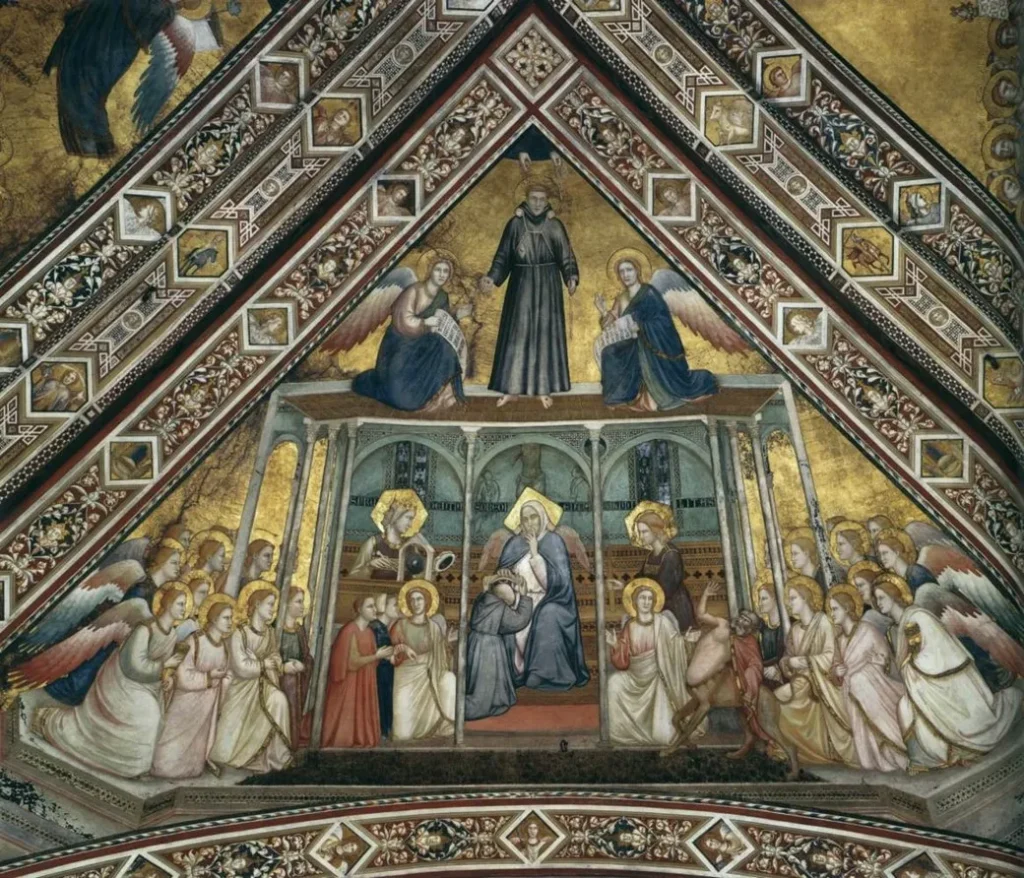
The franciscan friary (sacro convento) and the lower and upper basilicas (italian: basilica inferiore e superiore) of francis of assisi were started to pay tribute to this neighborhood holy person, following his canonization in 1228. Simone di pucciarello gave the land for the congregation, a slope at the west side of assisi, known as “slope of misery” (italian: colle d’inferno) where beforehand hoodlums were executed. Today, this slope is designated “slope of heaven”.
On 16 july 1228, francis was consecrated by pope gregory ix in assisi, and he established the groundwork stone of the new church the next day, despite the fact that development may as of now have been started. The development having been started at his request, the pope proclaimed the congregation to be the property of the papacy. The congregation was planned by maestro jacopo tedesco, who was in those days the most renowned architect.[3] the development was regulated by sibling elias of cortona, perhaps the earliest adherent of holy person francis and the previous vicar general of the request under holy person francis. The lower basilica was done in 1230. On pentecost 25 may 1230, the remaining parts of holy person francis were gotten a grave parade to the lower basilica from its brief entombment place in the congregation of san giorgio (st. George), presently the basilica of holy person clare of assisi. The internment place was hidden for dread that st francis’ remaining parts may be taken and scattered. The development of the upper basilica was started after 1239 and was finished in 1253. Both places of worship were blessed by pope honest iv in 1253.
Pope nicholas iv, a previous priest general of the request for franciscans, raised the congregation to the situation with ecclesiastical church in 1288. The piazza del loge, the square prompting the congregation, is encircled by corridors built in 1474. They housed the various travelers running to this congregation. In 1818, the remaining parts of holy person francis were rediscovered underneath the floor of the lower basilica. In the rule of pope pius vii the tomb was constructed with the goal that the reliable could visit the entombment spot of the holy person.
On 27 october 1986 and january 2002, pope john paul ii assembled in assisi with in excess of 120 delegates of various religions and christian categories for a world day of petition for harmony.
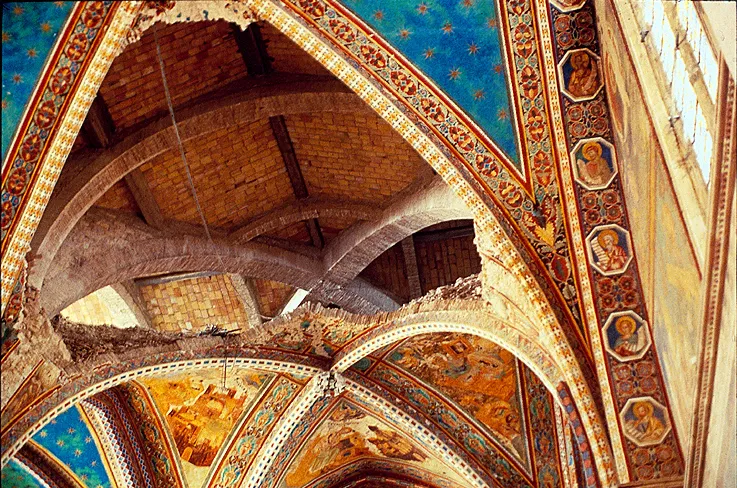
On the morning of september 26, 1997, two powerful seismic tremors struck the region around assisi, measuring magnitudes of 5.7 and 6.0, respectively. The quakes caused widespread devastation, with many ancient buildings either destroyed or severely damaged. While a team of experts and friars were assessing the damage to the basilica of saint francis, a secondary tremor struck, leading to the collapse of the basilica’s dome. Tragically, two franciscan monks and two experts lost their lives in the collapse. The giotto frescoes depicting the life of saint francis in the upper church suffered minor damage, while the frescoes on the sections of the dome that fell were completely destroyed. The basilica was closed for several months for repairs and restoration. The collapse was captured on film.
Architecture of The Basilica of Saint Francis Of Assisi

Architects: Elias of cortona, lapo tedesco
Architectural Styles: Romanesque Architecture, Italian Gothic Architecture
Burials: Saint Francis Of Assisi, Jacoba Of Settesoli, John Of Brienne, Bohuslav Matěj Černohorský, Angeline Of Marsciano
The basilica of saint francis of assisi was designed by maestro jacopo tedesco on two levels, each consecrated as a church. The two sections are known as the “basilica superiore” (upper basilica) and the “basilica inferiore” (lower basilica). The lower church was originally designed as a large crypt to support the upper church. In the 19th century, an additional lower crypt was constructed beneath the basilica. Architecturally, the exterior of the basilica integrates seamlessly with the friary of st. Francis, as the friary’s lofty arcades provide support and stability to the church, perched on a hillside.
Architectural Style and Design
The basilica’s design is a fusion of romanesque and gothic styles, establishing many of the defining features of italian gothic architecture. Both the upper and lower churches were originally built with a simple cruciform layout. This plan included an aisle-less nave divided into four square bays, a square crossing, and a transept with projections on each side. The lower church’s apse is semicircular, while the upper church’s apse is polygonal. To the left of the church stands a romanesque bell tower.
Lower Church Features
The lower church was constructed entirely in the romanesque style, featuring low, semi-circular ribbed cross-vaults over the nave and barrel vaults over the transept arms. Between 1350 and 1400, several chapels were added to expand the space. The main entrance is through a gothic doorway built between 1280 and 1300, later enclosed by a renaissance-style porch in 1487. The entrance’s rose window, often referred to as “the eye of the most beautiful church in the world,” is a significant decorative feature.
Upper Church Features
The upper church boasts a whitewashed brick façade divided into two horizontal zones, each about equal in height, with a simple gable of the same height as the lower zones. The main gothic-style doorway is separated by a central column, with a rose window set in the tympanum above. In the second zone above the door, a large romanesque-style rose window is surrounded by carved symbols of the four evangelists. Above it, in the gable, there is an ocular window. To the left of the façade, visible from both the upper and lower churches, is the benediction loggia, built in the baroque style in 1754 when the church was raised to the status of a basilica.
Interior Design
Internally, the upper church preserves brother elias’ original aisleless cruciform design. The nave consists of four bays with ribbed cross-vaulting. Unlike the lower church, the diagonal ribs are semi-circular, while the transverse ribs are pointed in the gothic style, rising to the full height of the diagonal ribs. These ribs spring from clustered columns, and both the columns and vaults are supported by robust semi-circular buttresses.
Stained Glass And Frescoes
The basilica is renowned for its gothic windows with geometric tracery, including windows in each bay of the nave and in the polygonal apse. The apse windows were created by german craftsmen active in assisi at the end of the 13th century. The left side of the nave features windows made by a french workshop (1270), while the right side’s windows are attributed to the workshop of maestro di san francesco. These stained glass windows are regarded as some of the finest examples of 13th-century italian glasswork.
Unlike many churches where stained glass dominates the decor, the basilica primarily uses frescoes to convey its religious messages. The lower church houses some of the earliest frescoes, which were completed in a series of stages by various artists, including notable names like cimabue and giotto, along with many lesser-known contributors. These frescoes are a crucial aspect of the church’s artistic legacy.
Upper Basilica Of St. Francis Of Assisi
The upper basilica of st. Francis of assisi is renowned for its bright and spacious interior, characterized by a single four-bay nave, a transept, and a polygonal apse. The cross-vaulted ceiling is adorned with intricate patterns of crosses and leaves, while the four ribbed vaults alternate between golden stars set against a blue background and detailed paintings. The second vault features roundels with busts of christ and saint francis, and the virgin mary and saint john the baptist. The entrance vault showcases the four latin doctors of the church: saint gregory facing saint jerome and saint ambrose facing saint augustine. These remarkable frescoes are attributed to the isaac master. The choir area is furnished with 102 wooden stalls, which are decorated with delicate carvings and marquetry by domenico indovini (1501). At the center of this area stands the raised papal cathedra.
Crucifixion By Cimabue
The west end of the transept and the apse are decorated with frescoes by cimabue and his workshop, dating from around 1280. One of the most impressive works is the crucifixion, which depicts saint francis kneeling at the foot of the cross, emphasizing his deep reverence for the passion of christ. Unfortunately, many of cimabue’s frescoes suffered significant deterioration over time due to the use of lead oxide and improper application on dry plaster, resulting in their near-complete decay. Before cimabue, an anonymous northern master, possibly an english artist, created decorations in the upper right section of the transept around 1267-1270. These include two lunettes and roundels on the west wall depicting the angel and the apostles. Additionally, the roman master painted isaiah and david on the remainder of the wall under the eastern lunette.
The Life Of Isaac Frescoes
The upper part of the nave, heavily damaged in the 1997 earthquake, is decorated with a series of 32 frescoes illustrating both the old and new testaments. The scenes range from the creation of the world to joseph forgiving his brothers and from the annunciation to the women at the tomb. The frescoes were completed by various masters, including giacomo, jacopo torriti, and pietro cavallini, and each bay took around six months to complete.
The frescoes depicting the life of isaac, including the scenes of isaac blessing jacob and esau, are traditionally attributed to the young giotto (1290–1295), though this has been debated. Some art historians believe these works were created by the isaac master, a roman artist whose style links him to pietro cavallini, who may have influenced these frescoes. The isaac master’s contributions are considered a breakthrough in the use of the buon fresco technique, which became influential in the centuries that followed.
The Life Of Saint Francis
The most significant decorations in the upper basilica are the series of 28 frescoes, attributed to the young giotto, which depict the life of saint francis. The frescoes are positioned along the lower part of the nave, with each bay featuring three frescoes on either side, as well as additional frescoes on the entrance wall and in the east galleries. Giotto’s depictions are based on the legenda maior, a biography of saint francis written by saint bonaventure (1266). These scenes are so vivid that they give the impression of giotto having witnessed the events himself. The frescoes were completed between 1296 and 1304.
The authorship of these frescoes, however, has been questioned, as early attributions were unclear. While many italian critics still attribute the works to giotto and his workshop, others suggest that they were the work of at least three different painters, who followed giotto’s original concept. These artists are known as the master of the legend of saint francis, the master of the obsequies of saint francis, and the cecilia master.
The first span of the ceiling features frescoes of the four doctors of the church: jerome, augustine, gregory, and ambrose. These are also attributed either to a young giotto or one of his followers. The third span of the ceiling showcases four heart-shaped medallions depicting christ, the virgin mary, john the baptist, and saint francis, painted by jacopo torriti. The façade of the upper basilica is crowned by a gothic portal with twin doors and an exquisite rose window. In addition, there is a permanent exhibition featuring a sculpture titled tau, created by guido dettoni della grazia.
The Lower Basilica Of Saint Francis Of Assisi: Architecture, Chapels, And Frescoes
Brother elias, who had gained experience constructing massive sepulchres from hard rock in syria, designed the lower basilica as a vast crypt with ribbed vaults. The entrance is framed by a large rose window, flanked by two smaller ones, often referred to as “the eye of the most beautiful church in the world.” the wooden doors of the basilica are adorned with intricate carvings: the left door’s decorations were executed by ugolinuccio da gubbio around 1550, while the right door was done by an anonymous umbrian artist in 1573. These carvings depict stories from the lives of saint francis, saint clare, saint louis, and saint anthony. The left porch wall also features the bust of pope benedict xiv, who granted the church the title of patriarchal basilica and cappella papale. Following pope benedict xvi’s theological act in 2006, renouncing the title of “patriarch of the west,” the basilica’s name was changed to the papal basilica of saint francis.
Upon entering the lower basilica, visitors encounter the chapel of saint catherine of alexandria, built around 1270. Enlarged by gattapone da gubbio, this chapel was further decorated with frescoes by ‘andreas pictor de bononia’ (likely andrea de’ bartoli) in 1368–1369. The chapel also features stained glass windows by giovanni di bonino of assisi, dating from the mid-14th century. A small chapel of saint sebastian lies to the left, with a canvas by giorgetti and life episodes of saint sebastian painted by g. Martelli in 1646. On the left wall, paintings by ottaviano nelli and a 14th-century depiction of saint christopher can be found.
On the right side of the entrance stand two monumental tombs: the mausoleum of giovanni de’ cerchi, topped with a porphyry vase, and the mausoleum of john of brienne, king of jerusalem. Above the latter stands a statue of the blessed virgin, with a crowned woman seated on a lion, created by cosmatesco around 1290. The frescoes adorning the third section of the entrance, painted by cesare sermei and g. Martelli in 1645, have deteriorated significantly.
The lower basilica’s central nave, flanked by semi-circular arch side chapels, is richly decorated with some of the oldest frescoes in the church, attributed to the maestro di san francesco. These frescoes, completed between 1260 and 1263, portray five scenes from the passion of christ on the right and five scenes from the life of saint francis on the left, symbolizing the franciscans’ belief in saint francis as a second christ. The nave is connected by a low, blue-painted ceiling with golden stars, while many of the images on the lower walls have deteriorated. Notable surviving fragments include the virgin and child with an angel by cimabue.
Side chapels, built between 1270 and 1350 for noble families, disrupted some of the original frescoes. The san martino chapel, dedicated to saint martin of tours and built by cardinal gentile portino da montefiore, was decorated between 1317 and 1319 by simone martini with ten frescoes from the saint’s life. The adjacent st. Peter of alcantara chapel is located on the left side. On the right side of the nave, chapels are dedicated to saints louis of toulouse, stephen i of hungary, anthony of padua, and mary magdalene. The chapel of mary magdalene, built by teobaldo pontano, contains works from giotto’s workshop, possibly painted by giotto himself around 1320. The life of mary magdalene is depicted on the lateral walls, while the vault features roundels with busts of christ, the virgin, mary magdalene, and lazarus.
The nave ends in a richly decorated semicircular apse, which is preceded by a transept with barrel vaulting. The frescoes in the right transept, depicting the childhood of christ, were painted partly by giotto and his workshop, while the nativity scene was created by the anonymous maestro di san nicola. Three frescoes by giotto show saint francis intervening in favor of two children, illustrating the saint’s miraculous powers. Cimabue’s famous maestà with saint francis (1280), likely the closest likeness of saint francis, is displayed on the transept wall, contrasting with the lively frescoes of giotto. The chapel of saint nicholas of bari, located at the northern end of the transept, was commissioned by cardinal napoleone orsini. It contains the tomb of giovanni orsini and features a frescoed triptych by giotto’s school. The southern end of the transept houses the chapel of saint john the baptist, commissioned by cardinal orsini but left incomplete.
The left transept is decorated by pietro lorenzetti and his workshop (1315–1330) in a series of tempera frescoes that remain his masterworks. These include six scenes from the passion of christ, with the fresco of the deposition of the cross being especially emotional. Beneath the monumental “crucifixion” fresco, lorenzetti painted the madonna and child, accompanied by saints john the evangelist and saint francis.
The papal altar, constructed from a single block of stone from como in 1230, sits at the apse’s center. It is surrounded by gothic arches supported by columns in various styles. The gothic walnut choir stalls, completed in 1471, were created by apollonio petrocchi da ripatransone, tommaso di antonio fiorentino, and andrea da montefalco. The apse was originally adorned with frescoes by stefano fiorentino, depicting the crucifixion, but these were destroyed in 1622. Today, the walls feature a “last judgment” fresco by cesare sermei di orvieto (1609–1668). The vaults above the apse, painted between 1315 and 1320 by the maestro delle vele, depict the triumph of saint francis and allegories of obedience, poverty, and chastity. The stained glass windows in the lower basilica are attributed to giovanni di bonino and his workshop, showcasing the exceptional artistry of 14th-century assisi.
Crypt
Mostly down the nave one can slip into the sepulcher by means of a twofold flight of stairs. This entombment spot of holy person francis was seen as in 1818. His remaining parts had been concealed by sibling elias to forestall the spread of his relics in archaic europe, a story told by jon m. Sweeney in the enthusiast.[11] by request of pope pius vii a grave was worked under the lower basilica. It was planned by pasquale belli with valuable marble in neo-traditional style. In any case, it was overhauled in uncovered stone in neo-romanesque style by ugo tarchi somewhere in the range of 1925 and 1932.
The old stone casket with iron ties is cherished in an open space over the special stepped area. In 1934 his most steadfast siblings were buried toward the edges of the wall around the special stepped area: sibling rufino, sibling angelo, sibling masseo and sibling leo. At the entry of the sepulcher, a urn with the remaining parts of jacopa dei settesoli was added to the grave. This lady of roman respectability, tenderly alluded to as “sibling jacoba”, was the most reliable companion and benefactress of holy person francis. She was next to him in the porziuncola at the hour of his demise.
Friary of Saint Francis
Close to the basilica stands the sacro convento friary with its monumental walls with 53 romanesque curves and strong braces supporting the entire complex. It overshadows the valley beneath, giving the impression of a stronghold. It was worked with pink and white stone from mount subasio. It was at that point occupied by the ministers in 1230. However, development consumed most of the day, with as result various styles mixing : romanesque with gothic style. A significant part was worked under the rule of pope sixtus iv, a franciscan, somewhere in the range of 1474 and 1476.
The friary presently houses a tremendous library (with middle age codices and incunables), an exhibition hall with show-stoppers gave by pioneers as the centuries progressed and furthermore the 57 masterpieces (fundamentally of florentine and sienese schools) of the perkins assortment. The spire, in romanesque style, was done in 1239.
Feast Day
Feast Day : Saint Vitus’ Feast Day Is On 04 October.
Pope gregory ix canonized saint francis of assisi on july 16 1228. The feast day of saint francis of assisi is celebrated on october 4 every year in the catholic church. During the feast, it is popular for people to bring their pets and other animals to church for blessing.
Church Mass Timing
Lower Church:
Holy Masses:
7:15am, 11:00am, 05:00pm,
Holidays
7.30am, 9.00am, 10.30am, 12.00pm, 5.00pm, 6.30pm
Church Opening Time:
Monday : 6:00 am – 7:00 pm
Tuesday : 6:00 am – 7:00 pm
Wednesday : 6:00 am – 7:00 pm
Thursday : 6:00 am – 7:00 pm
Friday : 6:00 am – 7:00 pm
Saturday : 6:00 am – 7:00 pm
Sunday : 6:00 am – 7:00 pm
Contact Info
Address :
Piazza inferiore di s. Francesco, 2, 06081 assisi pg, italy.
Phone : +39075819001
Accommodations
Connectivities
Airway
The nearest airport to the church of papal basilica and sacred convent of saint francis in assisi, italy, is, santa maria degli angeli, 06081 province of perugia, italy, which is just 17 min (7.7 km) via viale patrono d’italia/sr147dir away from the basilica.
Railway
The nearest railway to the church of papal basilica and sacred convent of saint francis in assisi, italy, is, san francesco d’assisi airport via dell’aeroporto, snc, 06134 perugia, pg, italy, which is 25 min (15.6 km) via sr147 away from the basilica.

